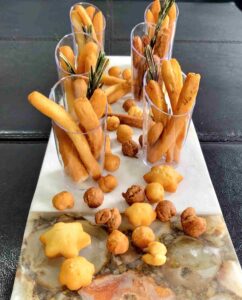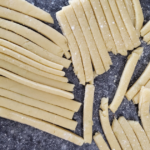
Food That Reminds You of Home
In a fast-moving world, with migration and globalization being the order of the day, food many a time serves as a comforting reminder of home. To many immigrants and those exposed to diverse culinary traditions, some foods are capable of evoking quite vivid memories of homeland. At All African Delights, we share this emotional understanding for food and home regarding our product Chin Chin.
The History of Chin Chin
Chin Chin is a popular healthy snack within several West African countries, including Nigeria, Ghana and Cameroon. This delicious snack is prepared from dough, usually made from flour, sugar, butter, eggs and milk, and then deep fried till it attains a golden color and gets a crispy texture to it. This snack originally forms part of the festive celebrations in tradition
This simplicity and diversity have made Chin Chin a snack easily adoptable in new regions with different personal touches over the years, making it the snack to all young and old.
Cultural Significance of Chin Chin

To many people across West Africa, Chin Chin means much more than just as a crunchy snack, it represents a symbol of celebration and togetherness. It showcases joy, hospitality, brotherhood, and that sense of community at functions or at gatherings. Making Chin Chin is a communal activity, bringing families and friends together by sharing the tasks involved and enjoying the fruits of one’s efforts.
For immigrants elsewhere in the world, this cultural imperative multiplied many times over, Chin Chin would serve as nostalgic reminder for their constant yearning back home. It gives them a link between their past times and present. The familiar taste and feel of Chin Chin can stir up memories of childhood, family gatherings, and the rich cultural heritage of their homeland.
Bringing Authentic Flavors to the Market
 At All African Delights, it is our core mission to show the real essence of traditional African cuisines and share this with the world. Chin Chin is baked from authentic recipes, carefully prepared with the finest ingredients, and is one of the real nostalgic flavors taken in for taste by our customers. But what stands out our Cameroon Chin Chin to others are it is less sugary and ideal crunchy with vanilla, chocolate and lemon flavour and it also comes with different shapes and sizes.
At All African Delights, it is our core mission to show the real essence of traditional African cuisines and share this with the world. Chin Chin is baked from authentic recipes, carefully prepared with the finest ingredients, and is one of the real nostalgic flavors taken in for taste by our customers. But what stands out our Cameroon Chin Chin to others are it is less sugary and ideal crunchy with vanilla, chocolate and lemon flavour and it also comes with different shapes and sizes.
We take immense pride in our rigorous preparation process for preservation of flavors as much as possible to cater the authentic quality and safety demands of contemporary times. Here’s a view from behind the scenes on how we make our Chin Chin:
- Fine Ingredients: We make our Chin Chin with the finest ingredients so that you get to have flavor and texture in every bite.
- Traditional Techniques: We follow the traditional method to prepare the dough, cut slender pieces, and fry it to perfection.
- Attention to Detail: Each batch of chin-chin is left under the supervision to achieve its perfect golden color and crispy texture, exactly as our customers know and love it for.
The Universal Appeal of Chin Chin
 Chin Chin is the food that reminds you of home. While Chin Chin has its roots in West Africa, its appeal is universal. Our diverse range of flavors and authentic recipes resonate deeply with people from various cultural backgrounds. Whether our customers come from India, Europe, Asia, or other parts of the world, they find comfort and familiarity in our products. Our customers who have tried Chin Chin have claimed to be similar food like that in their countries as follows:
Chin Chin is the food that reminds you of home. While Chin Chin has its roots in West Africa, its appeal is universal. Our diverse range of flavors and authentic recipes resonate deeply with people from various cultural backgrounds. Whether our customers come from India, Europe, Asia, or other parts of the world, they find comfort and familiarity in our products. Our customers who have tried Chin Chin have claimed to be similar food like that in their countries as follows:
- Khabse, a Tibetan snack is a deep-fried Tibetan biscuit that is traditionally prepared during the Tibetan New Year Losar. The khabse dough is made with flour, eggs, butter and sugar same as Chin Chin and is then shaped into different shapes and sizes.
- Uraro, an arrowroot cookie, are Filipino cookies made from arrowroot flour. They have a dry and powdery texture and are usually flower shaped.
- Kulkul, a traditional, deep-fried, Goan sweets twisted into small curls is popularly prepared during festivals like Diwali and Holi.
- Pasta Fritta, an Italian snack made from flour, yeast, salt, and sugar is also similar to Chin Chin.
- Mandazi, a snack from Kenya is a fried bread that originated on the Swahili Coast.
- Ollybollen is a form of Dutch doughnut that is fried and traditionally eaten on New Year’s Eve often eaten with raisins baked inside and powdered sugar on top.
- Shakkarpara,a crispy sweet savoury Indian delight that are eaten on different festivals in India.
This connection to home is one of the most powerful emotions that nourishes brand loyalty across diverse communities. In that capture what is traditional about African cuisine, but with flavor and flair familiar and comforting to many different cultural tastes, we created something quite special, unique yet inclusive culinary experience that exceeds geographical boundaries.
Food has a way of setting so many memories and bridging a great many gaps. To us, Chin Chin is more than just a snack, it has become a bond that spans gaps into the past, reminder of home, and a celebration of cultural heritage. Join us in this journey to experience real flavors of Chin Chin as we celebrate rich traditions of culinary art from Africa.







